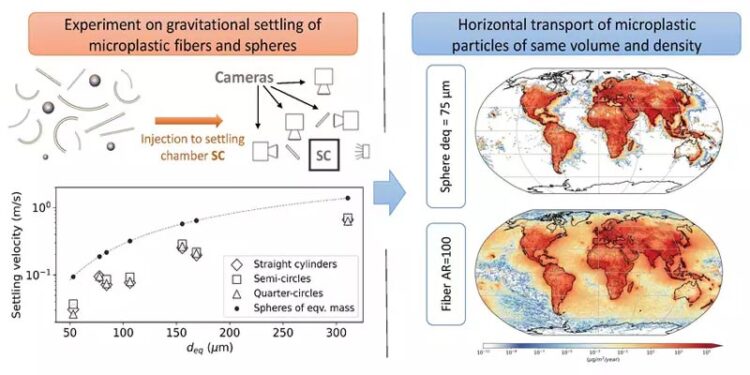Shape matters: How microplastic travels that far

An interdisciplinary team from the University of Vienna, Austria and the Max Planck Institute for Dynamics and Self-Organisation in Göttingen, Germany, developed an innovative combination of laboratory experiments and model simulations: The researchers first determined experimentally how fast microplastic fibers settle in the atmosphere. Afterwards, they implemented the results into a global atmospheric transport model. The differences of fibers to spherical particles were dramatic: fibers with lengths of up to 1.5 mm could reach the most remote places of Earth, even the stratosphere.
© Daria Tatsii, Universität Wien & Taraprasad Bhowmick, MPI-DS
New study: Microplastic fibers are settling substantially slower than spherical particles in the atmosphere and might even reach stratosphere.
How far microplastics travel in the atmosphere depends crucially on particle shape, according to a recent study by scientists at the University of Vienna and the Max Planck Institute for Dynamics and Self-Organisation in Göttingen: While spherical particles settle quickly, microplastic fibers might travel as far as the stratosphere. In the article published in the journal Environmental Science & Technology, the researchers argue that further studies are urgently needed to investigate the possible influence of microplastics on the atmosphere.
Microplastic particles can be found in the most remote corners of our planet. For some places, such as Arctic glaciers and ice sheets, atmospheric transport is the only conceivable pathway. However, it is puzzling how some quite large and mostly fiber-like microplastics found their way to such places, even though atmospheric transport models predict that such large particles fall out of the atmosphere close to their sources.
The study by an interdisciplinary group of scientists from the University of Vienna, Austria and the Max Planck Institute for Dynamics and Self-Organisation in Göttingen, Germany, has approached this puzzle via an innovative combination of laboratory experiments and model simulations. The researchers first determined experimentally how fast microplastic fibers settle in the atmosphere and found that fibers settle substantially slower than spheres of the same mass.
Lack of data on microplastic fibers in air
Mohsen Bagheri of the Max Planck Institute for Dynamics and Self-Organisation, who oversaw the laboratory experiments, comments: “Surprisingly, there is almost no data in the literature on the dynamics of microplastic fibers as they settle in air. This lack of data is largely due to the challenges of conducting controlled and repeatable experiments on such small particles in air. With advances in submicron-resolution 3D printing and the development of a novel experimental setup that allows tracking of individual microplastics in air, we were able to fill this knowledge gap and improve existing models in this study”.
The researchers then implemented a model describing the settling process of non-spherical particles into a global atmospheric transport model. The differences to spherical particles were dramatic: fibers with lengths of up to 1.5 mm could reach the most remote places of Earth in the model, while the model showed that spheres of the same mass settled much closer to the plastic source regions.
Daria Tatsii from the Department of Meteorology and Geophysics at the University of Vienna, the first author of the study, says: “With the novel laboratory experiments and modelling analysis, we certainly reduce uncertainties about the atmospheric transport of fibers and can finally explain via modelling why microplastics reach very remote regions of the planet. An important result of the study is that our analysis is applicable not only to microplastics, but also to any other particles such as volcanic ash, mineral dust, pollen, etc.”.
Fibers might have an impact even on the stratosphere
Another finding is that, in the model, plastic fibers could reach much greater heights in the atmosphere than spheres of the same mass. Andreas Stohl of the University of Vienna who initiated the study comments: “This could have implications for cloud processes and even for stratospheric ozone, since it seems possible that microplastic fibers are abundant in the upper troposphere and might even reach the stratosphere. For instance, we cannot rule out that chlorine contained in these particles is harmful to the ozone layer. However, right now we do not even know how much plastic, and in which sizes and shapes, is emitted to the atmosphere, and we also do not know what happens to it under the extreme conditions of the upper troposphere and stratosphere. We are lacking very basic data. But given the dramatic increase in global plastic production, we have to be watchful.”
Despite all uncertainties, one thing is clear from the paper: The often peculiar shapes of microplastic particles need to be considered when investigating their environmental impact.
Wissenschaftliche Ansprechpartner:
Gholamhossein (Mohsen) Bagheri
Group leader, Scientist
+49 551 5176-391
gholamhossein.bagheri@ds.mpg.de
Originalpublikation:
https://pubs.acs.org/doi/10.1021/acs.est.3c08209
Weitere Informationen:
Media Contact
All latest news from the category: Interdisciplinary Research
News and developments from the field of interdisciplinary research.
Among other topics, you can find stimulating reports and articles related to microsystems, emotions research, futures research and stratospheric research.
Newest articles

Innovative 3D printed scaffolds offer new hope for bone healing
Researchers at the Institute for Bioengineering of Catalonia have developed novel 3D printed PLA-CaP scaffolds that promote blood vessel formation, ensuring better healing and regeneration of bone tissue. Bone is…

The surprising role of gut infection in Alzheimer’s disease
ASU- and Banner Alzheimer’s Institute-led study implicates link between a common virus and the disease, which travels from the gut to the brain and may be a target for antiviral…

Molecular gardening: New enzymes discovered for protein modification pruning
How deubiquitinases USP53 and USP54 cleave long polyubiquitin chains and how the former is linked to liver disease in children. Deubiquitinases (DUBs) are enzymes used by cells to trim protein…




